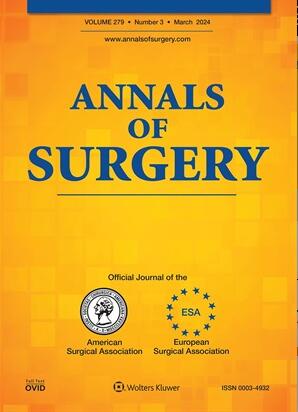Randomized Controlled Trial of New Oral Anticoagulants Versus Warfarin for Post Cardiac Surgery Atrial Fibrillation: The NEWAF Trial.
IF 6.4
1区 医学
Q1 SURGERY
引用次数: 0
Abstract
OBJECTIVE To determine whether anticoagulation for new onset atrial fibrillation (AF) with rivaroxaban decreases length of stay compared to warfarin. SUMMARY OF BACKGROUND DATA Direct Oral Anticoagulants (DOACs) have been shown to be noninferior to warfarin for stroke prevention in nonsurgical patients with atrial fibrillation. There are no published randomized trials comparing DOACs to warfarin in cardiac surgery patients, and DOACs are yet to be widely adopted in this population. METHODS In a pragmatic, prospective, clinical trial, 100 patients with new-onset AF after cardiac surgery were randomized to receive rivaroxaban (n=50) or warfarin (n=50). Patients were followed for 30 days post-discharge, with patient-reported outcomes assessed two weeks after discharge using the Perception of Anticoagulant Treatment Questionnaire and the EuroQol-5D-3L survey. RESULTS The primary endpoint, length of stay (LOS) from day of surgery to discharge (days, IQR), was 7 (6-9) for rivaroxaban and 8 (6-9) for warfarin (P=0.460). LOS from initiation of anticoagulation to discharge was 2 (1-4) days for rivaroxaban and 2 (1-3) days for warfarin (P=0.738). The mean INR at discharge in the warfarin group was 1.68 (SD 0.5). No major bleeding events, strokes, or other arterial thromboembolism events occurred in either group. Minor bleeding events were reported in 3/50 (6%) patients in the rivaroxaban group versus 1/50 (2%) in the warfarin group (P=0.617), none of which required blood transfusion. One patient (2%) in the rivaroxaban group developed a pericardial effusion requiring drainage, compared to none in the warfarin group (P=1.000). Patients taking rivaroxaban reported significantly higher scores for convenience (P<0.001) and better overall perception of their anticoagulation experience (P=0.006), though both groups reported similar treatment satisfaction (P=0.494). Mobility issues were reported by 42.2% of patients taking rivaroxaban compared to 18.6% of those taking warfarin (P=0.021). All outcomes were consistent in both the intention-to-treat and as-treated populations. CONCLUSIONS Treatment with rivaroxaban in new-onset atrial fibrillation after cardiac surgery did not decrease length of stay compared to warfarin. However, patients treated with rivaroxaban reported significantly better convenience and a more favorable overall perception of their anticoagulation experience compared to warfarin. Given similar safety profiles, these findings support incorporating rivaroxaban as an option for shared-decision-making when selecting anticoagulation therapy for this patient population.新型口服抗凝剂与华法林治疗心脏手术后房颤的随机对照试验:NEWAF试验。
目的探讨利伐沙班抗凝治疗新发房颤(AF)与华法林相比是否能缩短住院时间。直接口服抗凝剂(DOACs)已被证明在预防房颤非手术患者卒中方面优于华法林。目前还没有发表的比较DOACs和华法林在心脏手术患者中的随机试验,DOACs在这一人群中尚未被广泛采用。方法在一项实用、前瞻性的临床试验中,100例心脏手术后新发房颤患者被随机分为利伐沙班(n=50)和华法林(n=50)两组。患者出院后随访30天,出院后两周使用抗凝治疗感知问卷和EuroQol-5D-3L调查评估患者报告的结果。结果主要终点,从手术日到出院的住院时间(LOS)(天,IQR),利伐沙班组为7(6-9),华法林组为8 (6-9)(P=0.460)。利伐沙班开始抗凝至出院的LOS为2(1-4)天,华法林为2(1-3)天(P=0.738)。华法林组患者出院时平均INR为1.68 (SD 0.5)。两组均未发生大出血事件、中风或其他动脉血栓栓塞事件。利伐沙班组3/50(6%)的患者报告有轻微出血事件,华法林组1/50(2%)的患者报告有轻微出血事件(P=0.617),均无需输血。利伐沙班组有1例(2%)患者出现心包积液需要引流,而华法林组无一例(P=1.000)。服用利伐沙班的患者报告的便捷性评分明显更高(P<0.001),对抗凝治疗体验的总体感知更好(P=0.006),尽管两组患者报告的治疗满意度相似(P=0.494)。服用利伐沙班的患者中有42.2%报告了活动能力问题,而服用华法林的患者中有18.6%报告了活动能力问题(P=0.021)。在意向治疗和已治疗人群中,所有结果都是一致的。结论与华法林治疗相比,利伐沙班治疗心脏手术后新发房颤的住院时间没有缩短。然而,与华法林相比,接受利伐沙班治疗的患者报告了明显更好的便利性和更有利的抗凝体验。鉴于类似的安全性,这些研究结果支持在选择抗凝治疗时将利伐沙班作为共同决策的选择。
本文章由计算机程序翻译,如有差异,请以英文原文为准。
求助全文
约1分钟内获得全文
求助全文
来源期刊

Annals of surgery
医学-外科
CiteScore
14.40
自引率
4.40%
发文量
687
审稿时长
4 months
期刊介绍:
The Annals of Surgery is a renowned surgery journal, recognized globally for its extensive scholarly references. It serves as a valuable resource for the international medical community by disseminating knowledge regarding important developments in surgical science and practice. Surgeons regularly turn to the Annals of Surgery to stay updated on innovative practices and techniques. The journal also offers special editorial features such as "Advances in Surgical Technique," offering timely coverage of ongoing clinical issues. Additionally, the journal publishes monthly review articles that address the latest concerns in surgical practice.
 求助内容:
求助内容: 应助结果提醒方式:
应助结果提醒方式:


